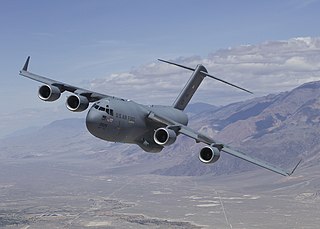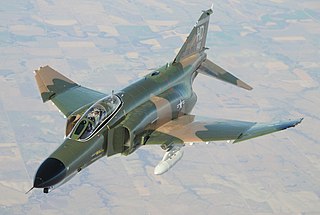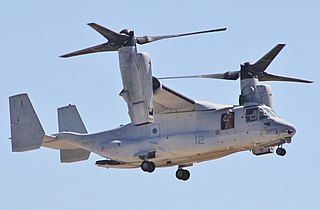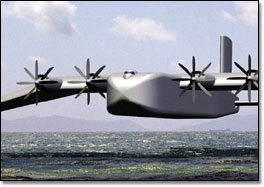
The McDonnell Douglas/Boeing C-17 Globemaster III is a large military transport aircraft that was developed for the United States Air Force (USAF) from the 1980s to the early 1990s by McDonnell Douglas. The C-17 carries forward the name of two previous piston-engined military cargo aircraft, the Douglas C-74 Globemaster and the Douglas C-124 Globemaster II.

The McDonnell Douglas F-4 Phantom II is an American tandem two-seat, twin-engine, all-weather, long-range supersonic jet interceptor and fighter-bomber originally developed by McDonnell Aircraft for the United States Navy. Proving highly adaptable, it entered service with the Navy in 1961 before it was adopted by the United States Marine Corps and the United States Air Force, and by the mid-1960s it had become a major part of their air arms. Phantom production ran from 1958 to 1981 with a total of 5,195 aircraft built, making it the most produced American supersonic military aircraft in history, and cementing its position as a signature combat aircraft of the Cold War.

The Bell Boeing V-22 Osprey is an American multi-mission, tiltrotor military aircraft with both vertical takeoff and landing (VTOL) and short takeoff and landing (STOL) capabilities. It is designed to combine the functionality of a conventional helicopter with the long-range, high-speed cruise performance of a turboprop aircraft. The V-22 is operated by the United States and Japan, and is not only a new aircraft design, but a new type of aircraft that entered service in the 2000s, a tiltrotor compared to fixed wing and helicopter designs. The V-22 first flew in 1988 and after a long development was fielded in 2007. The design essentially combines the vertical takeoff ability of a helicopter, but the range of a fixed-wing airplane.

The Boeing CH-47 Chinook is a tandem-rotor helicopter originally developed by American rotorcraft company Vertol and now manufactured by Boeing Defense, Space & Security. The Chinook is a heavy-lift helicopter that is among the heaviest lifting Western helicopters. Its name, Chinook, is from the Native American Chinook people of Oregon and Washington state.

A military aircraft is any fixed-wing or rotary-wing aircraft that is operated by a legal or insurrectionary military of any type. Military aircraft can be either combat or non-combat:

Yokota Air Base, is a Japan Air Self-Defense Force (JASDF) and United States Air Force (USAF) base in the Tama Area, or Western Tokyo.

The Boeing X-45 unmanned combat air vehicle is a concept demonstrator for a next generation of completely autonomous military aircraft, developed by Boeing's Phantom Works. Manufactured by Boeing Integrated Defense Systems, the X-45 was a part of DARPA's J-UCAS project.

Carrier onboard delivery (COD) is the use of aircraft to ferry personnel, mail, supplies, and high-priority cargo, such as replacement parts, from shore bases to an aircraft carrier at sea. Several types of aircraft, including helicopters, have been used by navies in the COD role. The Grumman C-2 Greyhound has been the United States Navy's primary COD aircraft since the mid-1960s.

Boeing Defense, Space & Security (BDS) is a division of The Boeing Company based in Arlington, Virginia, near Washington, D.C. The division builds military airplanes, rotorcraft, and missiles, as well as space systems for both commercial and military customers, including satellites, spacecraft, and rockets.
The Boeing Bird of Prey was an American black project aircraft, intended to demonstrate stealth technology. It was developed by McDonnell Douglas and Boeing in the 1990s. The company provided $67 million of funding for the project; it was a low-cost program compared to many other programs of similar scale. It developed technology and materials which would later be used on Boeing's X-45 unmanned combat air vehicle. As an internal project, this aircraft was not given an X-plane designation. There are no public plans to make this a production aircraft. It is characterized as a technology demonstrator.

The Tri-Service aircraft designation system is a unified system introduced in 1962 by the United States Department of Defense for designating all U.S. military aircraft. Previously, the U.S. armed services used separate nomenclature systems.

The Boeing Pelican ULTRA was a proposed ground effect fixed-wing aircraft under study by Boeing Phantom Works in the early 2000s.

Since 1942 the United States has maintained air bases in the United Kingdom. Major Commands of the USAF having bases in the United Kingdom were the United States Air Forces in Europe (USAFE), Strategic Air Command (SAC), and Air Mobility Command (AMC).

The Bell Boeing Quad TiltRotor (QTR) is a proposed four-rotor derivative of the Bell Boeing V-22 Osprey developed jointly by Bell Helicopter and Boeing. The concept is a contender in the U.S. Army's Joint Heavy Lift program. It would have a cargo capacity roughly equivalent to the C-130 Hercules, cruise at 250 knots, and land at unimproved sites vertically like a helicopter.

Military light utility vehicle, or simply light utility vehicle (LUV), is a term used for the lightest weight class military vehicle category. A Jeep-like four-wheel drive vehicle for military use by definition lighter than other military trucks and vehicles, inherently compact and usually with light or no armour, with short body overhangs for nimble all-terrain mobility, and frequently around 4-passenger capacity.

The M1161 Growler is officially the Internally Transportable Light Strike Vehicle (ITV-LSV) designed specifically for use with the V-22 Osprey tiltrotor aircraft. The M1161 and M1163 are the only tactical vehicles certified to fly in the V-22. Fulfilling multiple roles of light utility, light strike and fast attack vehicle, the M1161 Growler is smaller than most international vehicles in the same role. It has taken over duties of the M151 jeep-type variants and replaced the Interim Fast Attack Vehicle (IFAV).

The Boeing Phantom Eye was a high altitude, long endurance (HALE) liquid hydrogen-powered unmanned aerial vehicle developed by Boeing Phantom Works. The aircraft was Boeing's proposal to meet the demand from the US military for unmanned drones designed to provide advanced intelligence and reconnaissance work, driven by the combat conditions in Afghanistan in particular. In August 2016, the Phantom Eye demonstrator was disassembled for display at the Air Force Flight Test Museum.

The Boeing Phantom Ray is an American demonstration stealth unmanned combat air vehicle (UCAV) developed by Boeing using company funds. The autonomous Phantom Ray is a flying wing around the size of a conventional fighter jet, and first flew in April 2011. It will conduct a program of test flights involving surveillance, ground attack and autonomous aerial refueling missions. The developers say it can carry 4,500 pounds of payload.

The Vertical Take-Off and Landing Experimental Aircraft program was an American research project sponsored by the Defense Advanced Research Projects Agency (DARPA). The goal of the program was to demonstrate a VTOL aircraft design that can take off vertically and efficiently hover, while flying faster than conventional rotorcraft. There have been many previous attempts, most of them unsuccessful as of 2015.

The M1297 Army Ground Mobility Vehicle, previously just GMV, and formerly called the Ultra Light Combat Vehicle (ULCV), is a U.S. Army airdroppable light off-road vehicle for light infantry brigades. The A-GMV is produced by General Dynamics. The design is closely based on the M1288 GMV 1.1, which is itself based on the Flyer 72.



















